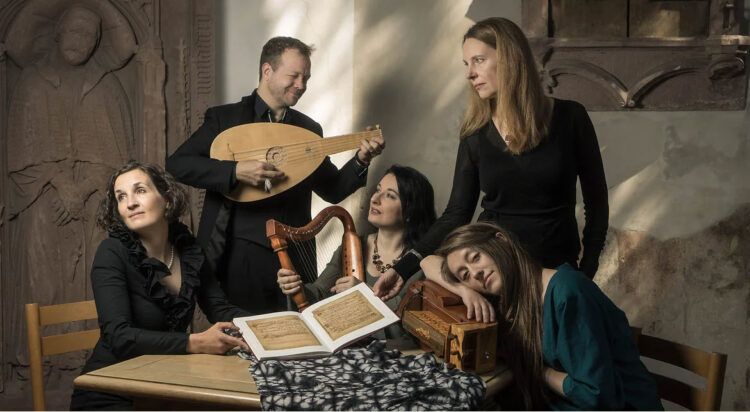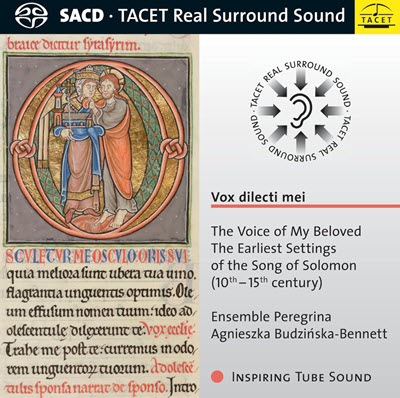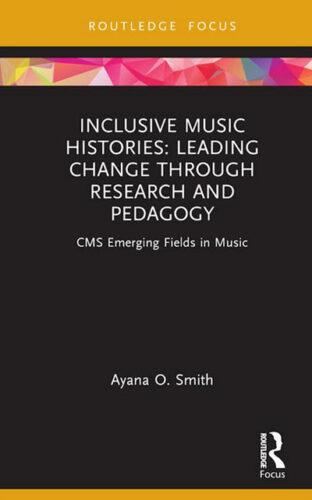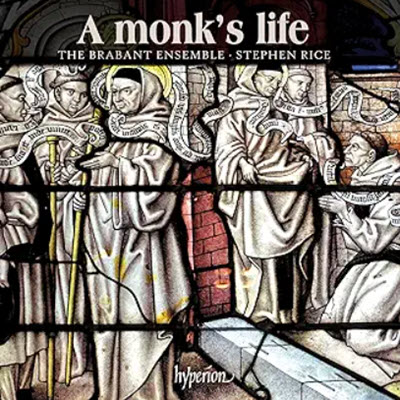by Karen M. Cook
Published May 6, 2024
Vox Dilecti Mei, The Voice Of My Beloved. The Earliest Settings of the Song of Solomon (10th – 15th Century) Ensemble Peregrina. Tacet TACET270

Since its establishment at the Schola Cantorum Basiliensis in 1997, Ensemble Peregrina has taken listeners on many an outlying path through repertoires rarely encountered in early-music recordings. Founded and led by Agnieszka Budzinska-Bennett, their albums have focused on lesser-known music from places as far afield as Poland, Silesia, Denmark, Finland, and Iceland, from unknown composers such as Wizlav of Rügen, and from the multitudes of unnamed composers and performers found in convents across medieval Europe. For their efforts, the ensemble has received numerous accolades, all entirely merited.

No less deserving is Vox Dilecti Mei, The Voice Of My Beloved, their latest album. Rather than focusing on a particular geographical location or composer, here the ensemble turns their attention to a particular repertory, namely settings of the Song of Songs. Certainly, such settings are widely known in later Medieval and Renaissance music. Works ranging from John Dunstaple’s Quam pulchra es to Thomas Crecquillon’s Nigra sum to Peter Phillips’s Veni in hortum meum all set passages from the Bible.
Here, though, the focus is on the earliest known settings of Song of Songs texts, a much less widely known and less frequently recorded repertory. In fact, some works were transcribed or constructed specifically for this album; the ensemble deciphered the opening track, Epithalamia, from its alphabetic notation, while the lengthy Regensburg Drama was compiled from related chants and antiphons. And Meliora sunt is a composite of a fifteenth-century setting from Silesia and, surprisingly, a 17th-century setting from Iceland. Most of these works are anonymous, although the liner notes explain that Sicut malum might, due to stylistic similarities, be by Hildegard von Bingen, and Quis est hic is likely to be by Bruno of Segni, an 11th-century Italian Benedictine.
Perhaps because so many Song of Songs settings were used for Marian liturgy, they were often more florid or technically demanding, which makes them exciting both to sing and to hear, and the fact that so many of these settings are set up as dialogues between different parties, such as a Bride and Bridegroom, allows the vocalists to inject a fine sense of character into the melodies.
Listen, for example, to the opening Epithalamia: the vielle sets the opening pitch, after which the ensemble implores the dancers to join in the celebration. The vielle shifts to a more florid accompaniment for Budzinska-Bennett as soloist, singing the role of Ecclesia, the bride of Christ. Later in the text, Matthieu Romanens enters, singing the role of Christ, before the ensemble rejoins them. The contrast between ensemble and soloists allows the latter to express the joy and passion of the bride and bridegroom in freer fashion. The ensemble handles the exceptional range of Hildegard(?)’s Sicut malum with aplomb, while the shifting textures of pieces such as Salve nobilis V. Odor tuus are a real treat, and the lower register of Vox dilecti is lovely. The two instrumental estampies inserted in the first half of the recording are a nice change of texture and tone, as well. Perhaps my personal favorite is the swirling, searching melody in In lectulo meo, sweetly sung by Lorenza Donadini.
It’s a rich and expressive album; the vocal quality is clear, and their overall intonation and blend are exceptional. Each track is at once familiar and a novel new sound world, and it makes for enjoyable listening indeed. Highly recommended.
Karen M. Cook is Associate Professor of Music History at the University of Hartford. She specializes in late medieval music theory and notation, focusing on developments in rhythmic duration. She also maintains a primary interest in musical medievalism in contemporary media, particularly in video games. For EMA, she recently reviewed revelatory Josquin from Cut Circle.




